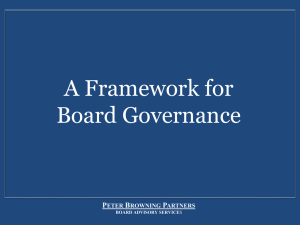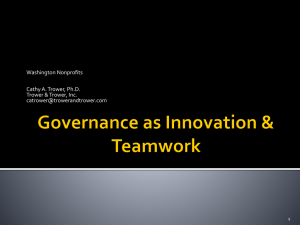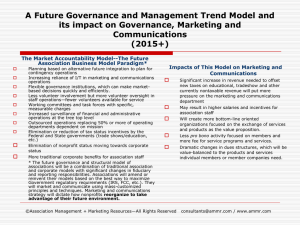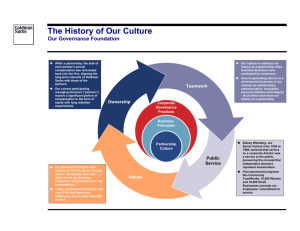Corporate Governance
advertisement
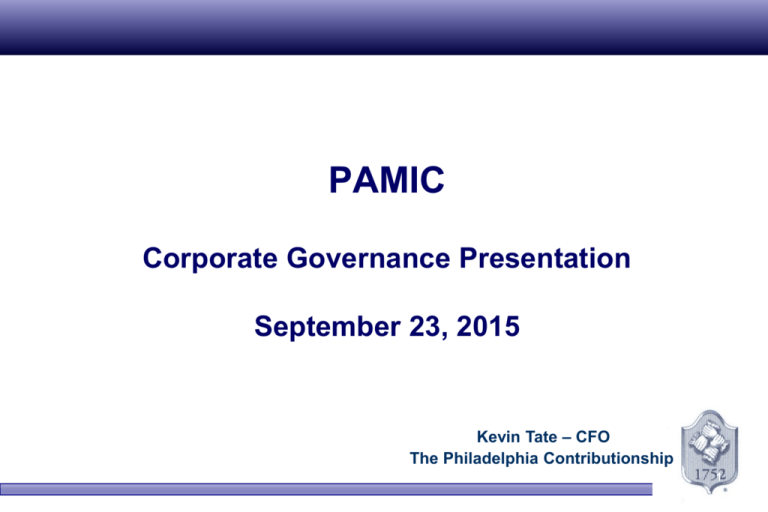
PAMIC Corporate Governance Presentation September 23, 2015 Kevin Tate – CFO The Philadelphia Contributionship 1 Corporate Governance Presentation Corporate Governance Annual Disclosure (“CGAD”) • What Is It? – Filing that includes narrative/documentation (no prescribed format) – Responding to inquiries relative to four key areas: • Governance framework and structure • Policies and practices of the Board and its Committees • Policies and practices for directing senior management • Oversight of critical risk areas • What Isn’t It? – Should not be construed to prescribe or impose Corporate Governance standards/ internal processes • Takeaway – Report and disclose your company’s practices re Corporate Governance 2 2 Corporate Governance Presentation CGAD Key Area #1 – Corporate Framework and Structure • Board and its Committees • How are they structured and governed? • How is Board leadership structured? • What are roles and duties of Chairman and CEO? • Company Response – Narrative and Documentation • # of Board Members • Listing of Board Committees • Investment, Executive, Audit, Compensation, Risk, Nominating, etc. • Company By Laws and Committee Charters • Items requiring Board/Committee approval • CEO job description 3 3 Corporate Governance Presentation CGAD Key Area #2 – Policies and Practices - Board and its Committees • Board Policies and Practices • Qualifications of each Board/Committee member, including Independence • Frequency of meetings and Board/Committee member attendance • How are Board/Committee members selected? Term limits? • Performance evaluation and compensation? • Company Response • Bios of Board Members – All are independent • Meeting schedule and attendance records • Members are paid only for meetings they attend • Selection of Members – Responsibility of Nominating Committee • Compensation – Board Compensation Surveys • Performance - ??? Self Evaluation - ??? 4 4 Corporate Governance Presentation CGAD Key Area #3 – Direction of Senior Management • • Direction of Senior Management • Suitability Standards – Appropriateness of experience, background and integrity • Code of Conduct and Business Ethics • Succession Plans – CEO and Senior Management • Performance Evaluation and Compensation Company Response • Hiring Practices – Resumes, references, psychological profile/testing • Code of Ethics and Conflict of Interest Policy Statement – Signed annually by all EEs • Succession Planning • Individual Development Plans for all EEs • Key Employee Retention – Managed Risk within ERM • Performance Evaluation/Compensation • Annual Performance Reviews • Bi - Annual Compensation Surveys – Base and bonus • Short Term Incentive Comp – Financial (U/W profit, production, expense management) and individual performance goals • Long Term Incentive Comp – Surplus Growth 5 5 Corporate Governance Presentation CGAD Key Area #4 – Oversight of Critical Risk Areas • How does Board and its Committees ensure proper oversight of critical risk areas? • Delegation of responsibilities between Board/Committees/Management • Method by which Board/Committees are informed re: • Strategic and Business Plans and associated business risks • Critical risk areas – How are they managed and how frequently reported up to Board/Committees? • Company Response • Delegation of responsibilities –By Laws, Committee Charters and Actions Requiring Board Approval • Business Plans – Presented annually and performance vs Plan evaluated quarterly • Critical Risk Areas – ERM Dashboard – Quarterly reporting to Risk Committee • 24 Identified Risks • 9 Managed Risks – Risk Tolerances Established re 6 of these • 15 Monitored Risks 6 6

